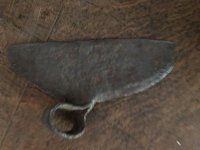Hello,
I’m a new member and I’m hoping you can help. I bought what I think is a very old iron broad axe head. I use it as a paper weight (smile). It’s iron and the “loop” at the top is probably bent. I’d like to know for sure what it is and it’s approximate age. Thank you in advance,
Linda in Cincinnati
I’m a new member and I’m hoping you can help. I bought what I think is a very old iron broad axe head. I use it as a paper weight (smile). It’s iron and the “loop” at the top is probably bent. I’d like to know for sure what it is and it’s approximate age. Thank you in advance,
Linda in Cincinnati











